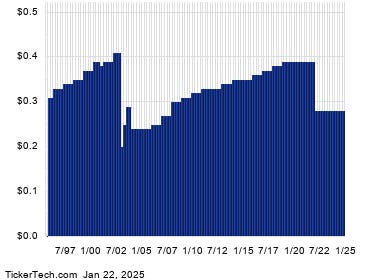The allure of AT&T’s dividend yield exceeding 5% presents a compelling case for income-seeking investors. This attractive yield, derived from an annualized dividend of $1.11 per share and a trading price as low as $22.02, highlights the significance of dividends in generating overall investment returns. Historically, dividends have played a crucial role in bolstering stock market gains, often offsetting price declines and contributing substantially to total returns. The example of the S&P 500 ETF (SPY) between 1999 and 2012 underscores this point. Despite a slight decrease in share price over the period, the accumulated dividends significantly boosted the total return, showcasing the power of dividends in long-term investment strategies. A yield exceeding 5%, like that offered by AT&T, becomes even more appealing when compared to the relatively modest average annual return of the S&P 500 during that same period, even with dividends reinvested. This naturally raises the question of the sustainability of such a high yield, a factor that warrants careful consideration.
The importance of dividend income in investment portfolios cannot be overstated. While share price appreciation contributes to capital gains, dividends provide a consistent stream of income that can be used to supplement other income sources or reinvested to further compound returns. The power of reinvesting dividends lies in the ability to purchase additional shares, which in turn generate more dividends, creating a snowball effect over time. This compounding effect can significantly amplify returns over the long term, particularly for companies with a history of stable or increasing dividend payouts. However, it’s crucial to remember that dividend payments are not guaranteed and can fluctuate based on a company’s financial performance. Therefore, assessing the sustainability of a dividend yield is paramount before making investment decisions.
AT&T’s inclusion in the S&P 500 index signifies its standing as a large-cap company, indicating a degree of stability and market recognition. This membership in a widely followed index often attracts institutional investors and provides a level of comfort for individual investors. However, even blue-chip companies can experience periods of financial difficulty, impacting their ability to maintain dividend payouts. Therefore, relying solely on a company’s S&P 500 membership as a guarantee of dividend sustainability is not advisable. A thorough analysis of the company’s financial health, including its earnings, cash flow, and debt levels, is essential to evaluate the long-term prospects of its dividend payments.
The sustainability of AT&T’s attractive dividend yield is a critical question that investors must address. While the current yield appears enticing, it’s essential to delve into the company’s historical dividend payments and financial performance to assess the likelihood of its continuation. Examining AT&T’s historical dividend chart provides valuable insights into its track record of dividend payments, including any instances of cuts or increases. This historical context helps gauge the company’s commitment to dividend payouts and its ability to maintain them through various economic cycles. A consistent history of dividend payments can signal financial stability and management’s prioritization of shareholder returns.
Furthermore, analyzing AT&T’s profitability trends is crucial in determining the sustainability of its dividend. Dividend payments are ultimately funded by a company’s earnings, and a decline in profitability can put pressure on dividend payouts. Evaluating AT&T’s revenue growth, profit margins, and free cash flow generation provides insights into its ability to generate sufficient cash to cover its dividend obligations. A healthy and growing free cash flow is particularly important as it indicates the company’s ability to sustain and potentially increase its dividend payments in the future.
In conclusion, AT&T’s dividend yield above 5% presents an attractive opportunity for income-seeking investors. However, it’s crucial to exercise caution and conduct thorough due diligence before making any investment decisions. While historical dividend payments and S&P 500 membership provide some context, a comprehensive analysis of AT&T’s financial health, including its profitability, cash flow, and debt levels, is essential to assess the long-term sustainability of its dividend. The enticing yield should be viewed in conjunction with a thorough understanding of the company’s financial fundamentals to make informed investment choices. Remember, past performance is not necessarily indicative of future results, and dividend payments are not guaranteed. A prudent approach involves considering all available information and assessing the company’s overall financial strength to determine the likelihood of continued dividend payments at the current rate.

